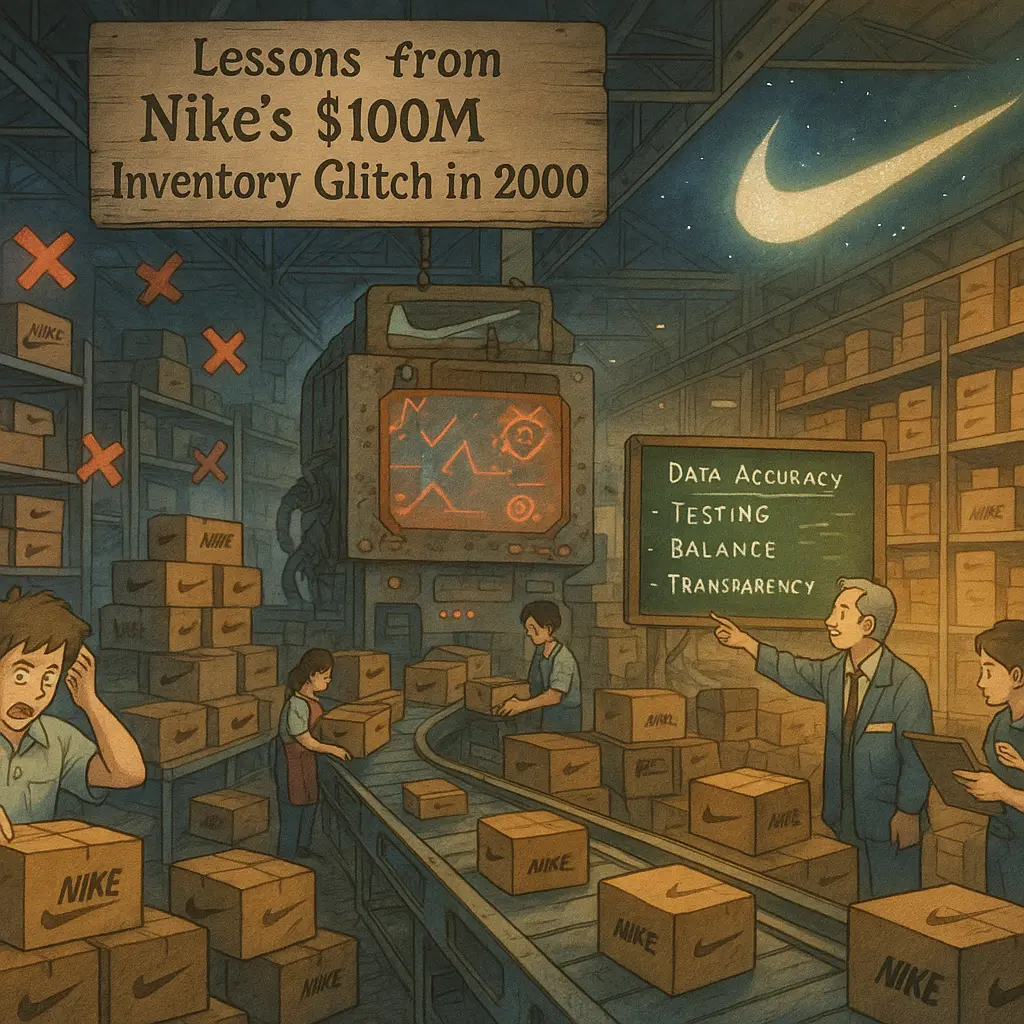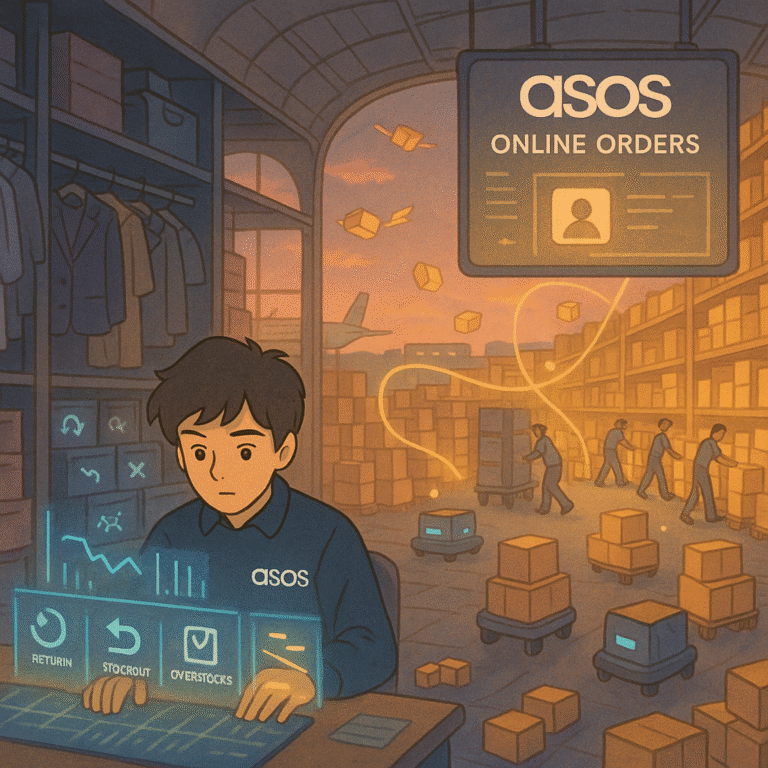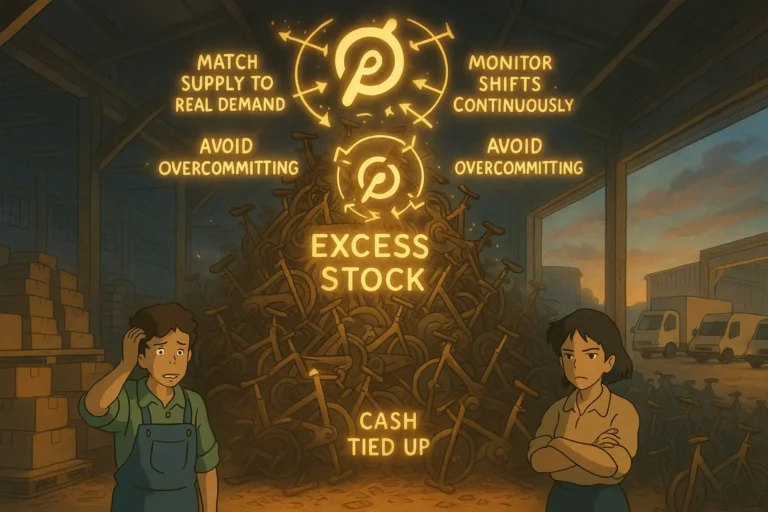
Nike's Inventory Glitch
Many supply chains have taken a flawed approach to their automated forecasting. The common belief is “just feed it data and it will predict demand.” However, Nike’s inventory glitch is proof that this approach can put your supply chain operations in considerable trouble.
Article Brief & Key Nuggets
- Nike lost over $100 million in 2000 due to a failed rollout of its supply chain software.
- The glitch was caused by poor data integration, rushed implementation, and overreliance on automation.
- Nike recovered by rebalancing human judgment and systems, enhancing training, and gradually implementing changes.
- African supply chains and global logistics leaders can avoid similar mistakes by starting small, investing in deep training, and aligning their systems with reality.
Nike’s $100 million inventory glitch was not a system problem. It was a strategy problem. In 2000, the just feed it and predict model backfired, proving that no software, no matter how sophisticated, can fix a flawed planning process.
Do you want more supply chain stories like this? Subscribe here
Nike Supply Chain Failure: What Happened in 2000
Ultimately, Nike wanted speed. By the late 1990s, the company had 27 different ordering systems scattered across the world. Planning cycles ran for nine months or longer. And products often reached stores too late or too early—rarely on time.
Nike responded with a $400 million digital overhaul called the Nike Supply Chain (NSC) project. It paired SAP ERP with customer tools from Siebel and, critically, predictive demand planning software from i2 Technologies.
The goal was to reduce lead times from nine months to six, predict demand more accurately, and order the exact amount of stock needed. On paper, the goal was commendable. But in real life, it backfired.
The i2 software was launched in 2000. Immediately, orders began flowing to the wrong places. Factories made the wrong shoes. Stores ran out of popular models like Air Jordans while others—like the Air Garnett III—piled up in warehouses.
To make it work, retailers slashed prices and Nike air-freighted some inventory at eight times the usual cost. But the supply chain was a disaster.
Nike’s CEO, Phil Knight, captured the mood when he said, “This is what I get for $400 million, huh?” It was a cutting reference to the project’s hefty cost.
The company warned investors about a 28% drop in quarterly earnings. Naturally, the stock plummeted nearly 20% in a single day. When the dust had settled, the total damage exceeded $100 million.
Read more: Hyundai’s Semiconductor Strategy: Navigating the 2021 Chip Shortage.
But Why Did Nike’s ERP Implementation Fail?
Nike’s inventory glitch wasn’t just a software error. It was a full-system breakdown. Here’s why the Nike demand planning software failed:
1. Over-Customization and Poor Data Fit
i2 Technologies had warned Nike to limit customization to 10-15%. But after investing $400 million in its supply chain technology, the company felt it was acceptable to modify the software to accommodate its own messy data. But the application was never designed to do that.
As a result, the system became unstable. It would delete orders and slow down operations. The custom features made it harder to maintain, which created bugs that were difficult to trace.
2. Rushed “Big Bang” Rollout
A Gartner analyst noted that Nike launched its new supply chain system in just over a year, which is half the time such large-scale projects typically take to complete. Nike did it in 12 months. With no safety net.
And instead of launching the system in phases, Nike switched everything on at once. This meant there wasn’t time for the team to test or learn how to use the application properly.
3. Poor Training and User Readiness
Planners using the system didn’t fully understand how it worked. Some couldn’t spot obvious errors in time. The lack of training meant small mistakes snowballed into larger breakdowns.
4. Weak Collaboration With the Vendor
Nike didn’t keep open lines of communication with i2. When things went wrong, the two teams blamed each other. i2’s president was shocked when Nike publicly blamed the software. He said, “Why were we never informed?”
5. Blind Faith in Algorithms
Nike treated the demand planning system as a “crystal ball.” It expected the software to get demand right every time. But the system didn’t understand Nike’s products, seasons, or market behaviors. It couldn’t predict what retailers hadn’t ordered yet.
Nike forgot the golden rule of forecasting. Good forecasting needs people as much as machines.
The Real Cost of Nike’s Inventory Glitch
Nike missed its earnings forecast by up to 28%, resulting in a loss of over $100 million in sales in one quarter.
But the ripple effects hurt deeper:
- Market panic: Nike’s stock dropped nearly 20% after the news broke.
- Brand strain: Retailers like Foot Locker cut prices to clear shelves. For example, Air Garnetts went from $140 to $90.
- Shipping chaos: To address delivery gaps, Nike paid as much as $8 per pair in air freight, compared to $0.75 by sea, to bridge these gaps.
It wasn’t just about money. Nike’s supply chain failure became a case study in business schools. It was called one of the worst ERP implementation mistakes in the retail sector.
Read more: Supply Chain Lessons from the GM Ventilator Project 2020.
How Nike Recovered from Its Supply Chain Software Failure
Although it was a disaster, Nike didn’t scrap the project. The company elected to fix it, which was more effective. But the recovery was painful.
Here is how:
1. Manual Workarounds
Nike engineers had to export and re-import data to bypass broken software logic. They rebuilt lost orders and created temporary bridges between systems.
2. Phasing out Problem Areas
Nike stopped using i2’s demand planner for its core shoe lines. Forecasting went back into SAP, where it was easier to manage. Human input took priority again.
3. Deep Training Culture
Nike made training mandatory for employees. The training was for 180 hours, and staff were locked out of the system until they had completed the 180 hours.
4. Slow and Steady Continuation
The rest of the NSC program continued, though this time it was at a slower pace. Instead of finishing in two years, it took six, and the patience paid off. By 2004, Nike had shortened its lead times from nine months to six.
Factory inventory buffers shrank from a month to one week, and gross margins improved.
Most of all, the company stuck to its original vision. Leaders did not panic. The then-CEO, Phil Knight, expressed frustration—but kept going. His faith in the long-term value of the system helped the team push through.
Read more: The Failures and Success of Walmart’s RFID Mandate in 2003.
Lessons from Nike’s Inventory Glitch
Nike’s supply chain mistakes are avoidable, and the wins are replicable.
But here’s what to remember:
1. Don’t Rush Implementation
Switching systems overnight rarely works. Rollouts should be slow, phased, and tested under real conditions. That’s especially true in supply chain planning, where a glitch can spread quickly.
2. Fix Data Before Plugging in New Tools
If the data is outdated, inconsistent, or fragmented, any system will fail. Demand planning software depends on clean, structured data.
3. Customize Less, Align More
There is no one-size-fits-all approach to supply chain operations, even within the same industry. Customization is ok, but avoid bending software too far to fit bad processes. Sometimes it’s better to change the process or pick different tools than force a misfit.
4. Invest in Training. Then Double it
Training is not optional. It’s a must. A well-trained team spots mistakes early, but an untrained one lets small errors spiral.
5. Forecasting is Never 100% Automated
Even the best algorithm can’t read the market like a seasoned planner can. Combine models with experience. Let humans adjust system outputs when they don’t “pass the smell test.”
6. Communicate With Your Vendors
Don’t hide problems from your software partners. Keep a shared record of bugs, limits, and performance issues. If things go wrong, fix them together.
Do you want more supply chain stories like this? Subscribe here
How African Supply Chains Can Apply These Lessons
African logistics teams face their own unique challenges, including limited resources, informal trade, and inconsistent infrastructure. However, the lessons from Nike’s inventory glitch and supply chain case study remain relevant.
1. Start Small and Clean Your Data
Avoid “big bang” ERP deployments. Begin with pilot sites and test planning tools in low-risk categories before scaling up.
It is also important to gather accurate inventory numbers, standardize SKUs, and build trust in internal data first. The system is only as good as the numbers it sees.
2. Don’t Over-Customize Imported Solutions
Many global tools don’t fit African market realities out of the box. However, it is essential to exercise caution when customizing. Use middleware or APIs instead of deep code changes where possible.
3. Prioritize People Over Platforms & Stick to Your Strategy
Hire and train planners who are familiar with your products, markets, and customers. Use tech to support their judgment—not replace it.
When a mistake happens, don’t pull the plug too fast. Adjust, learn, and fix the fault. But don’t lose the vision.
Supply chains in Africa don’t need to match Nike’s scale to face similar risks.
They only need one wrong order, one missed demand signal, one broken integration to lose trust with customers. But with careful steps and clear minds, they can build systems that are faster, smarter, and far more resilient.

Obinabo Tochukwu Tabansi is a supply chain digital writer (Content writer & Ghostwriter) helping professionals and business owners across Africa learn from real-world supply chain wins and setbacks and apply proven strategies to their own operations. He also crafts social content for logistics and supply chain companies, turning their solutions and insights into engaging posts that drive visibility and trust.








